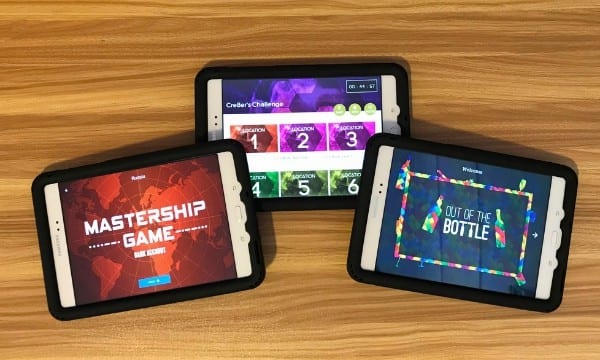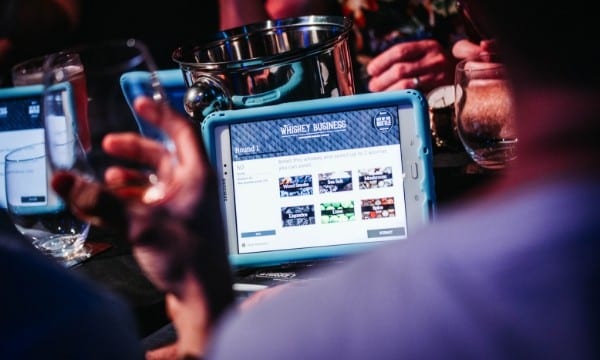
Our philosophy on how we use technology
As an interactive and immersive design company, we use several different disciplines to create our experiences; theatre, gaming, world creation, technology and narrative. The technology part of this is something we use for specific reason and we have refined our philosophy of its use within a live, hands-on experience.
Over the last two years we invested heavily in a building a complex technology piece from scratch. Our customers experience it is an app which runs on a tablet, but the whole system consists of an online experience builder (content management system) with live sync to a native Android app, integration with marketing software, live leaderboards and other technology such as Bluetooth Beacons and Augmented Reality (AR).
What role is technology playing
Within this fusion of disciplines, we have had to define the role that technology plays in the experiences we are designing. What makes this interesting is the different frameworks we have had to consider including a functional need, customer experience and narrative perspective.
From a functional perspectiveusing technology to innovate within our business has been game changing. It has allowed us to streamline our design process, scale our products, reduce running costs and has provided us with a stronger barrier for replication. Our technology has taken some functions that would have normally been manual and automated them, allowing us to reduce staffing costs to increase profit margins in the operation of our experiences. For some experiences, we are able to reduce running costs by up to 40%. Our technology also provides an intellectual property barrier that makes replication of our ideas much more difficult, ensuring we will stay at the forefront of experiential design.
From a customer experience perspective, the tension in our design is to use technology to enhance the experience, not bethe experience for our customers. Although technology can provide an amazing immersive or interactive customer experience, our design philosophy is anchored in a ‘live’ experience, meaning that customers can use all of their senses to engage in the world we create and with others. Think of it being like a live movie or video game.
This leads onto the next point:
From a narrative perspective, the use of technology must make sense and contribute to the world we have created rather than ‘break’ it. By breaking the world, we mean it being an anomaly that does not make sense within the broader construct and therefore breaks the sense of suspended belief by a participant. An example of how we integrated our technology to avoid breaking the world creation was within our production, Containment, where the tablets were narratively woven in as the personal device of a character. This made sense to the participants, who were trying to save that character. Another example is in our team building experience, Train Heist, in which participants are detectives and the tablet is the device used to contact and interact with a fellow detective based in the archives, gathering and sharing new information about the case with participants.
Ensuring there is a direct, intuitive connection between a technology use and the participant role has been a critical consideration within our design approach and use of technology.
Technology to enhance the experience, not to be the experience
We use technology, but we don’t use technology for the sake of technology. Any deployment has to be either solving a business problem or enhancing a customer experience significantly.
It is so tempting to use, design and deploy technology in new experiences to appear ‘innovative’, ‘relevant’ and ‘progressive’. We are certainly excited about emerging technology in the spaces of Augmented Reality, Virtual Reality and Artificial Intelligence. However, for us there is a danger that the technology is used simply because it is available, rather than to genuinely and significantly enhance the audience experience or meet a need within our company.
Having designed and delivered both technology and analogue experiences, when deciding which road to take, the critical factor has to be rooted in need, purpose and audience experience.
To keep us faithful to this principle, we have created a sense checking process when designing a new experience. This forces us to put a customer lens and a business lens over new ideas where we want to integrate technology. Rather than falling into the habit of continuing to invest in new features of functionality within our technology, by asking ourselves some hard questions we have found that there is often another, cheaper and customer centric solution that we can deploy and achieve the same outcome, if not a better outcome.
The intersection of entertainment and technology within our company
Particularly in the intersection of entertainment and technology we see an exciting space to play in, but we also can see that there is still magic in keeping the user experience simple, intuitive and analogue. In a world full of screens, we love what happens when there is an opportunity to engage in a new experience that does not rely on technology. On the other hand, you can genuinely make ‘magic’ happen through technology – a ghost floating through a wall, full immersion into a world you wouldn’t experience otherwise, interacting with a character long dead, streamlining a process or customer experience.
Maybe there is a middle ground and it does not have to be one or the other? I believe we struck a good balance in our production, Containment, in which the technology platform we used (in the form of a tablet device) allowed for a personalised audience experience while allowing us to scale to a capacity we would not have reached if we used an analogue solution.
The balance came when we put significant thought and effort into building ‘the world’ and integrated a series of characters that the audience interacted with that were strongly embedded in the environment external to the technology. From a critical perspective, I do wonder if putting a technology platform in the hands of the audience, making it the function heart of the experience, did take some of the focus away from the overall experience. This seemed evident as I watched teams constantly focused on the device – looking down rather than around. It is a question we continue to mull over.
It is also good to be reminded that just because you can use technology as the heart of an experience, you do not have to.
At the heart of our Philosophy
As technology continues to progress we will face this tension more and more (it’s very real!). How do we integrate technology without compromising the ‘world creation’, ‘human interaction’ and ‘outcome’ of the experience?
Our guiding light; always put the need and audience first.


0 Comments